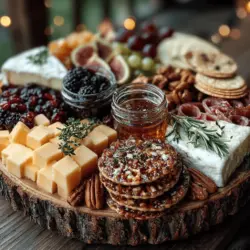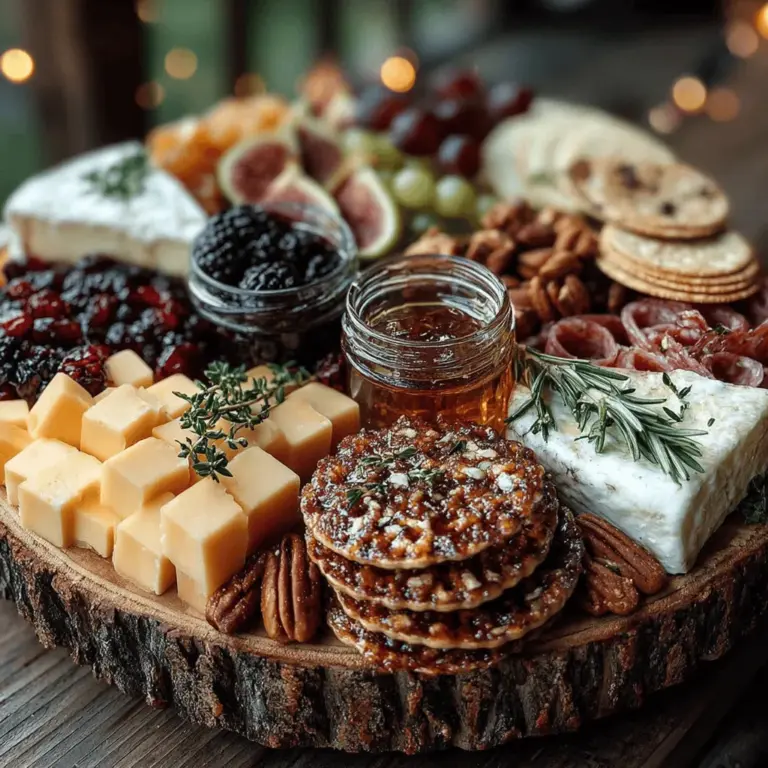Savory-Sweet Charcuterie Board Recipe
Introduction
Charcuterie boards have become a beloved centerpiece in social dining experiences, capturing the essence of communal sharing and culinary delight. These beautifully arranged platters invite guests to graze, mingle, and savor a variety of flavors and textures, making them perfect for gatherings ranging from casual get-togethers to elegant soirées. The allure of a charcuterie board lies not just in its visual appeal, but also in its ability to cater to diverse palates, providing something for everyone to enjoy.
Among the many variations of charcuterie boards, the savory-sweet charcuterie board stands out with its delightful fusion of flavors. This particular board artfully balances rich, savory elements such as cured meats and cheeses with sweet accompaniments like fruits and spreads, creating a harmonious tasting experience. This versatility allows it to adapt to various occasions, whether it be a festive holiday gathering, a romantic picnic, or an upscale wine and cheese night.
Understanding Charcuterie Boards
The term “charcuterie” originates from France and traditionally refers to the art of preparing and assembling cured meats and meat products. Over time, the concept has evolved, transforming into a broader culinary practice that includes a range of accompaniments like cheeses, fruits, nuts, and spreads. Charcuterie boards not only showcase the skill of the artisan but also represent the cultural significance of sharing food in a communal setting.
Historically, charcuterie was a means of preserving meats before the advent of refrigeration. Today, it serves as a celebration of flavors, textures, and presentation. A successful charcuterie board typically includes a variety of elements: a selection of cheeses, cured meats, fresh and dried fruits, nuts, and a spread or two. Each component adds its unique touch, creating a complex and engaging taste experience that encourages social interaction and conversation.
The Essentials of a Savory-Sweet Charcuterie Board
To create a savory-sweet charcuterie board that captivates your guests, it’s essential to understand the components that contribute to this balance. The key lies in selecting a variety of high-quality ingredients that complement each other. The interplay of flavors—from the creaminess of cheese to the saltiness of meats and the sweetness of fruits—creates a sensory experience that is rich and satisfying.
When curating your board, it’s also important to consider dietary preferences and restrictions. A well-planned charcuterie board can easily accommodate gluten-free and vegetarian options, ensuring that all guests can partake in the feast. Including a range of ingredients allows for personalization, enabling each person to create their own unique combinations, further enhancing the communal aspect of the meal.
Selecting Your Ingredients
The success of your savory-sweet charcuterie board hinges on the quality and variety of ingredients you choose. Here’s a closer look at the essential components:
Choosing the Right Cheeses
Cheese is arguably the heart of any charcuterie board. When creating a savory-sweet board, consider a diverse selection of cheeses to appeal to various tastes. A creamy Brie offers a rich and buttery flavor, while an aged cheddar provides sharpness and depth. Gouda, with its slightly sweet and nutty profile, can bridge the gap between savory and sweet elements beautifully.
When selecting cheeses, think about their textures and flavors. Soft cheeses like Brie pair well with fruits, while harder cheeses like aged cheddar can stand up to the robust flavors of cured meats. Aim for a mix of textures—creamy, crumbly, and firm—to create a multi-dimensional tasting experience.
Picking Cured Meats
Cured meats are another essential ingredient that adds depth and richness to a charcuterie board. Popular choices include prosciutto, salami, and chorizo. Prosciutto brings a delicate sweetness and melt-in-your-mouth texture, while salami offers a spiced, savory kick. Chorizo, with its bold flavors, can add a touch of heat if desired.
When pairing meats with cheese, consider the flavor profiles. For instance, the saltiness of prosciutto complements the creaminess of Brie, while the sharpness of cheddar pairs well with the robust flavors of salami. This interplay not only enhances the tasting experience but also encourages guests to experiment with their combinations.
Fresh and Dried Fruits
Fruits are crucial for achieving the sweet component of a savory-sweet charcuterie board. Fresh options like grapes, figs, and apple slices provide a refreshing contrast to the richness of meats and cheeses. Grapes, with their juiciness, can cleanse the palate, while figs add a unique sweetness that pairs well with creamy cheeses.
Dried fruits, such as apricots and cranberries, contribute additional sweetness and a chewy texture that complements the crunch of nuts and the softness of cheese. These fruits not only enhance the visual appeal of the board but also offer a variety of tastes that guests can enjoy.
Nuts and Olives
Finally, don’t underestimate the importance of mixed nuts and olives in your charcuterie board. Nuts provide a satisfying crunch and can introduce a variety of flavors, from salty to sweet, depending on the type chosen. Almonds, walnuts, and candied pecans can add delightful textures and tastes that enhance the overall experience.
Olives, on the other hand, bring a briny element that can balance out the sweetness of the fruits and the richness of the cheeses. Their unique flavors can serve as a palate cleanser, encouraging guests to continue tasting and exploring the different combinations available on the board.
By thoughtfully selecting these components, you’ll create a savory-sweet charcuterie board that is not only visually stunning but also a joy to eat. In the next part of this article, we will delve into the assembly of the board, tips for presentation, and ideas for pairing beverages that will elevate your charcuterie experience to new heights.
The Importance of Olives
Olives play a crucial role in the savory-sweet charcuterie board, adding a briny flavor that complements the rich and sweet elements of the board. Their unique taste profile not only enhances the overall flavor experience but also provides a delightful contrast to the creaminess of cheeses and the sweetness of fruits. When selecting olives, consider including a mix of varieties such as Kalamata, Castelvetrano, and green olives. This assortment will provide diverse flavor notes, from the mild, buttery flavor of Castelvetrano olives to the robust, tangy taste of Kalamata olives.
Condiments: Honey, Maple Syrup, and Mustard
Condiments can elevate your charcuterie board from good to exceptional. Honey and maple syrup are wonderful choices for drizzling over cheeses, adding a touch of sweetness that balances the saltiness of cured meats and the richness of the cheeses. For example, a soft goat cheese paired with a drizzle of honey creates a luxurious mouthfeel, while sharp cheddar can shine with a touch of maple syrup.
Mustard, on the other hand, provides a zesty kick that pairs beautifully with savory meats, enhancing their flavors without overpowering them. Whether you choose a grainy Dijon or a tangy whole grain mustard, these condiments invite your guests to experiment with flavor combinations and discover their favorites.
If you want to explore alternative condiments, consider options like balsamic glaze, fig jam, or even a spicy aioli. Each of these can add a unique twist to your charcuterie board, allowing for personalization based on your guests’ preferences.
Crafting the Perfect Charcuterie Board
Preparing Your Board
The foundation of an impressive charcuterie board begins with selecting the right serving vessel. A large wooden or stone board is ideal, as it provides ample space for arranging the various components. The natural materials not only add an aesthetic appeal but also enhance the rustic charm of the presentation.
Before serving cheese, it’s essential to bring it to room temperature to unlock its full flavor potential. Remove cheese from the refrigerator about 30 minutes before assembling your board. This slight adjustment in temperature allows the flavors to bloom, making each bite richer and more satisfying.
Arranging the Ingredients
Arranging your charcuterie board is an art form in itself. Here’s a step-by-step guide to help you create an eye-catching display:
1. Start with the Cheeses: Begin by placing your cheeses on the board. Space them evenly to allow for easy access. You can cut some pieces into wedges or cubes while leaving others whole for visual variety.
2. Add the Meats: Next, layer your cured meats around the cheeses. Roll or fold slices of prosciutto or salami into shapes to create height and interest.
3. Incorporate Fresh Fruits: Fill in the gaps with fresh fruits. Grapes, figs, and apple slices not only add color but also provide a refreshing contrast to the savory elements.
4. Include Nuts and Olives: Scatter nuts and olives throughout the board. Use small bowls for olives if you prefer to keep them contained and easy to serve.
5. Drizzle with Condiments: Position small bowls of honey, maple syrup, or mustard around the board. This encourages guests to explore different flavor pairings.
6. Garnish with Fresh Herbs: Finally, add fresh herbs like rosemary or thyme as a garnish. This step not only enhances the visual appeal but also adds a subtle aromatic quality to the board.
Creating Flavor Pairings
Encourage your guests to explore various combinations of flavors. For example, pairing a sharp cheddar with apple slices and a drizzle of honey creates a delightful balance. A creamy brie can be paired with figs and prosciutto for a rich, savory-sweet experience. By providing a variety of options, guests can curate their own tasting experiences, discovering unique flavor profiles that they may not have considered before.
Adding the Finishing Touches
Neat organization is key to an impressive charcuterie board. Ensure that each ingredient is well-spaced and presented in abundance. A cluttered board can overwhelm the senses, while a well-arranged board invites exploration. The use of fresh herbs not only enhances the aesthetic but also introduces a burst of freshness that can cut through richer flavors, making each bite more enjoyable.
Serving Suggestions
When it comes to serving your charcuterie board, there are several best practices to enhance the experience:
1. Serve at Room Temperature: As mentioned earlier, ensure all components are at room temperature. This maximizes flavor and makes the board more inviting.
2. Utilize Proper Utensils: Provide small serving utensils for cheeses and spreads to keep things sanitary and organized. Consider including cheese knives, toothpicks, or small tongs for ease of serving.
3. Best Occasions: Charcuterie boards are incredibly versatile and suitable for a range of occasions. Whether you’re hosting a casual gathering, a picnic in the park, or a holiday celebration, a charcuterie board can elevate the event. They also make excellent appetizers for dinner parties or festive gatherings, encouraging communal sharing and interaction among guests.
4. Encourage Interaction: The communal aspect of a charcuterie board is one of its greatest joys. Encourage guests to share and try different combinations, fostering a sense of connection and conversation around the food.
Conclusion
Creating a savory-sweet charcuterie board is not just about assembling food; it’s about crafting a delightful experience that invites sharing and exploration. The blend of flavors, textures, and colors makes each board unique and adaptable to various tastes and occasions. Whether you’re entertaining friends or enjoying a quiet evening at home, a charcuterie board provides an opportunity for creativity and connection.
As you gather with loved ones around the table, savor the memories created through food and the joy of discovering flavors together. The charcuterie board becomes a canvas for culinary expression, offering endless possibilities and a celebration of diversity in taste. So next time you plan a gathering, remember the charm of a beautifully crafted charcuterie board and let it be the centerpiece of enjoyment and togetherness.


